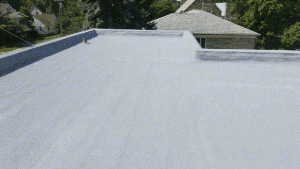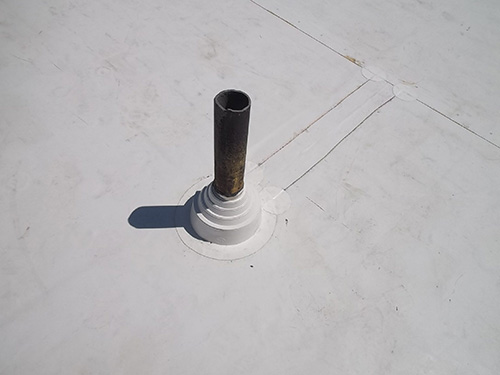Solar roofing is a trend that is growing from Fortune 500 companies to SMBs all over the US. With the cost-savings, inflation protection and contributions to saving the environment, it may be one of the best facility decisions you make.
But if you install those solar panels on a roof system that is not equipped to handle them, you can be causing more trouble than you are saving. In this article, we will cover solar panels, spray foam roofing and how they are a match made for your facility.
What is Spray Foam Roofing?

Spray Polyurethane Foam, more commonly referred to as SPF, is a liquid that is sprayed and expands into a foam, creating a solid layer across an existing roof. While SPF roofing is not the most known type of roofing material, the technology has been around since the early 1960s for industrial, commercial, and residential facilities.
Read More: Spray Polyurethane Foam (SPF) Roofing: Installation & Performance
For an average 20,000 sq. foot commercial roof, it will usually cost between $5.00 and $10.00 per square foot in materials and labor to install a typical SPF roofing system. This price range is for an SPF roof of average thickness and building structure. *
What are Solar Panels?
Solar panel roof systems, aka photovoltaic systems, are growing popularity for residential and commercial buildings. With a push for more sustainable power along with the affordability of solar panels, it is a no-brainer for some building owners who have roof space to spare.
See More: Solar Benefits for Business
In case you don’t know, solar panels are installed on the outside of your building and convert light from the sun into energy for your building to run on. The solar roof system on a roof is made up of solar cells bundled together to make a panel, that panel is then combined with other panels to make a grid.
Rooftop solar systems can vary significantly in size. Large-footprint buildings can employ solar systems rated from 50 kilowatts to 1,000 kW or larger while residential rooftop solar systems are commonly 3 kW to 5 kW. (Roofing Magazine)
How to Utilize Spray Foam When Installing Solar Panels
In addition to the actual panels, it takes a good amount of mechanical equipment to install these solar panel systems:
- Racks
- Rails
- Rooftop Attachment Devices
- Grounding Systems
- Wiring
- Wiring Harnesses
- Combiner Boxes
- Inverters
- Connection to Electrical Panel
All of these components can make your typical flat roof a very intricate balance between electronics, waterproofing, and insulation. Luckily, spray foam is a great roofing option to use in conjunction with your solar panel system.
Weight Control on Roof Structure
As you can imagine, all of those panels and electrical components can add a significant amount of weight to the top of your building structure, on average between 2-4 pounds per square foot.
With that kind of weight being installed, you want to take extra care with the weight of your roof system. A spray foam roof system will add less than a pound per square foot to your roof. Compared to a gravel roof that adds 5 – 10 pounds per square foot, a spray foam system is way easier on your building structure.
Accessing Equipment Safely
With any system that involves electricity, you will want the ability to quickly turn off or “shutdown” the system to perform maintenance or repairs safely. With spray foam roofing, you can access the essential components to your solar panel system without having to move gravel or other roofing components.
Waterproofing Installation Points

The racks holding the solar panels are mechanically fastened to your roof, you don’t want those expensive pieces of equipment falling off! Those points of installation are a massive vulnerability for leaks and heat/cool air loss.
With membrane systems, your contractor will have to create cuts in the membrane to work around the legs of the solar panel racks, similar to the vent you see in this image. With spray foam, you can have a contractor encase the entire installation point to form a seamless membrane going up the rack leg to stop leaks and keep your air inside the building.
Double Down on Going Green
If you are spending the money to install solar panels on your roof system, chances are you are trying to save money or the environment….or both! With spray foam roofing, you can double down on your investment.
Spray foam roofing will provide a higher insulation factor which will decrease your heating and cooling costs. You will also be using a sustainable roof system that will reduce your contribution to landfills.
Other Unique Uses of Spray Foam

Commercial Ductwork Insulation
Ductwork is one of the most important systems in your commercial building. According to Energy Star, 20 to 30 percent of the air that moves through a duct system is lost due to leaks, holes, and poorly connected ducts.
Improperly sealed ducts could contribute to energy loss for your facility and ultimately a monetary loss for your bottom line. A properly insulated ductwork system can protect your facility from variable temperatures, water damage, and mold.
Roof System Tie-Ins
Not all roofs are created equal. If you have multiple levels of roof systems or you have various types of roof systems, this can be a problem for potential leaks.
Spray foam can be utilized in an area where two different roof types meet. This area tends to collect substantial amounts of draining water as well as snow drifting. By installing the spray applied product, you create a seamless protective layer that prevents any water from backing up under the roof or flashings.
Non-Conventional Building Shapes
We have seen some unique buildings in our days, not every building is straightforward. The remarkable thing about spray foam is that your contractor creates a roof system as they apply the liquid onto your building. This means that they can cover non-conventional, even awkward shapes.
Traditional commercial roofing comes in prefabricated shapes – whether it’s a roll of the membrane or a sheet of metal. This means that the contractor has to work around your building shape, costing you time and money. The number of roof seams also increases when you introduce more pieces of roofing material.
Investing in a solar roof system is a big business decision when you are ready to invest, contact us to make sure your roof is prepared! If you have any further questions about your commercial roofing system, email us anytime at info@westroofingsystems.com or by filling out our form online to find out more.
*Cost ranges are general estimates; each roofing system is unique, and costs can vary. Please seek a professional quote for more specific and reliable costs.


